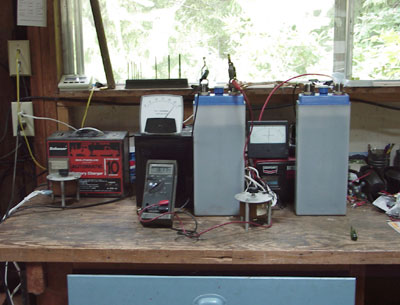Battery Score 2
Today, the Academy of Battery Rejuvenation graduated it's first cell:

The cell on the left is sitting at 1.617 volts after being charged at 2.6 amperes for 48 hours. The cell on the left is 24 hours into it's initial charge.
I'm using regular automotive-type battery chargers (the old kind, that don't require any voltage in the battery to turn on the output) set for 6 volt battery charging. To lower the voltage enough to keep the current in the proper range, I am running the AC power input to the chargers through individual Variac autotransformers, which allow me to dial in the current exactly.
The first cell displayed a perfect NiCd charging profile. It started out with the terminal voltage going very high (1.7 volts or so), then it quickly dropped to 1.38 volts, and very slowly gained voltage through the first 30 hours of charging. At about 33 hours, the voltage of the cell began to rapidly rise, indicating that the cell had reached about 90% charged state. All of this tells me that this particular cell is probably quite healthy.
Right after this photo was taken, I took the left hand cell off the charger and stored it away, moved the right hand cell to the left hand position, and cleaned the top of another dead cell to begin it's charging process. At this rate, I will have one cell coming off the charger each morning.
I also disassembled the battery of military-type cells, and began charging one of them at 1 ampere. Research on the 'net shows that these are indeed Mil-Spec cells. There are three manufacturers represented in this battery, SAFT, Gulton, and Marathon. All three cell manufacturers produced a basically identical product, so much so that one has to look carefully to tell them apart. My guess is that these cells were produced for aircraft use. Four of the cells are destroyed, with cracked open cases. Many more are totally dry inside, and still more have very low fluid levels. It will be quite a challenge to get all twenty of the remaining cells operable. I might have to settle for making up a single 12 volt battery of ten cells, and recycle the rest, we'll see.
I had the posts on the lead acid batteries changed because the round automotive posts are purported to have lower resistance to current flow, which is important in the EV, as it can draw 275 amperes over sustained periods. That and the fact that all of my interconnecting cables have round lead connectors, and I didn't want to have to change them to use the extra batteries. It was a good plan, but now I have some dancing around to do to get my tractor back in good nick.
Original material ©1996-2026 Mr. Sharkey | All rights reserved
